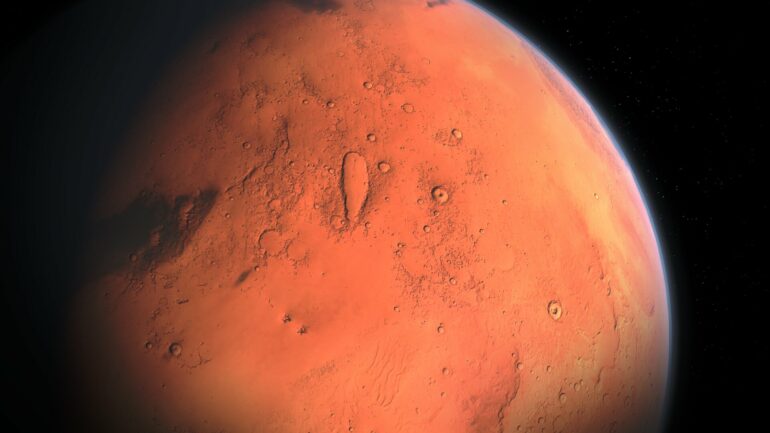The seismometer placed on Mars by NASA’s InSight lander has recorded its two largest seismic events to date: a magnitude 4.2 and a magnitude 4.1 marsquake. The pair are the first recorded events to occur on the planet’s far side from the lander and are five times stronger than the previous largest event recorded.
Seismic wave data from the events could help researchers learn more about the interior layers of Mars, particularly its core-mantle boundary, researchers from InSight’s Marsquake Service (MQS) report in The Seismic Record.
Anna Horleston of the University of Bristol and colleagues were able to identify reflected PP and SS waves from the magnitude 4.2 event, called S0976a, and locate its origin in the Valles Marineris, a massive canyon network that is one of Mars’ most distinguishing geological features and one of the largest graben systems in the Solar System. Earlier orbital images of cross-cutting faults and landslides suggested the area would be seismically active, but the new event is the first confirmed seismic activity there.
S1000a, the magnitude 4.1 event recorded 24 days later, was characterized by reflected PP and SS waves as well as Pdiff waves, small amplitude waves that have traversed the core-mantle boundary. This is the first time Pdiff waves have been spotted by the InSight mission. The researchers could not definitively pinpoint S1000a’s location, but like S0976a it originated on Mars’ far side. The seismic energy from S1000a also holds the distinction of being the longest recorded on Mars, lasting 94 minutes.
Both marsquakes occurred in the core shadow zone, a region where P and S waves can’t travel directly to InSight’s seismometer because they are stopped or bent by the core. PP and SS waves don’t follow a direct path, but rather are reflected at least once at the surface before traveling to the seismometer.
“Recording events within the core shadow zone is a real steppingstone for our understanding of Mars. Prior to these two events the majority of the seismicity was within about 40 degrees distance of InSight,” said Savas Ceylan, a co-author from ETH Zürich. “Being within the core shadow, the energy traverses parts of Mars we have never been able to seismologically sample before.”
The two marsquakes differ in some important ways. S0976a is characterized by only low frequency energy, like many of the quakes identified so far on the planet, while S1000a has a very broad frequency spectrum. “[S1000a] is a clear outlier in our catalog and will be key to our further understanding of Martian seismology,” Horleston said.
S0976a is likely to have a much deeper origin than S1000a, she noted. “The latter event has a frequency spectrum much more like a family of events that we observe that have been modeled as shallow, crustal quakes, so this event may have occurred near the surface. S0976a looks like many of the events we have located to Cerberus Fossae—an area of extensive faulting—that have depths modeled to be around 50 kilometers or more and it is likely that this event has a similar, deep, source mechanism.”
Compared to the rest of the seismic activity detected by InSight, the two new far-side quakes are true outliers, the researchers said.
“Not only are they the largest and most distant events by a considerable margin, S1000a has a spectrum and duration unlike any other event previously observed. They truly are remarkable events in the Martian seismic catalog,” Horleston said.
More information:
Anna C. Horleston et al, The Far Side of Mars: Two Distant Marsquakes Detected by InSight, The Seismic Record (2022). DOI: 10.1785/0320220007
Provided by
Seismological Society of America
Citation:
Two largest marsquakes to date recorded from planet’s far side (2022, April 23)



